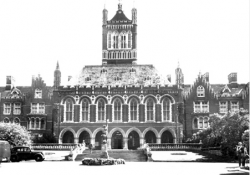Royal Holloway
| Royal Holloway | |
|---|---|
 | |
| Established | 1868 |
| Construction Began | 1873 |
| Opened | 1885 |
| Closed | 1992 |
| Current Status | Preserved |
| Building Style | Corridor Plan |
| Architect(s) | William Henry Crossland |
| Location | Virginia Water, Surrey |
| Architecture Style | Franco-Gothic |
| Alternate Names |
|
History[edit]
Holloway Sanatorium was founded by a wealthy entrepreneur, named Thomas Holloway, who had made an immense fortune through the sale of pills. He wished to bequeath his wealth to a suitable philanthropic cause and devised the idea of opening an asylum for the middle classes whose needs had hitherto been largely overlooked by county asylums which received large numbers of paupers and private establishments which took those rich enough to pay.
His aim was to build an asylum for ‘Persons of the reduced middle class who [would] pay a moderate income for their support’. It was to hold two hundred patients, of whom none were to be epileptic, paralysed or dirty. No patient was to remain there for more than a year, no hopeless cases were to be admitted, there was to be no readmission (although this rule seems to have been broken within a few years), and all patients were to come from the middle class. Unlike the bleak austerity of county asylums, which were often constructed and furnished more like prisons than hospitals, Holloway’s sanatorium was carefully planned to provide comfortable surroundings, exuberantly coloured and decorated in order to distract the attention of the patients from their mental afflictions.
In 1901 there were 384 patients and 210 resident staff and, in 1911, 368 patients and 227 resident staff. In 1903 the roof was struck by lightning, causing a small fire and £1,500 worth of damage. By January 1924 there were 351 patients (of whom 17 were boarders), with 80 day staff and 14 night staff on the male side and 72 on the female side (59 day and 13 night). The male side had 4 medical officers, one of whom was a woman. In the spring of that year, an outbreak of influenza had claimed the lives of 70 patients and staff.
The Sanatorium continued as a charitable foundation until 1948, when it was transferred to the National Health Service. A serious fire occurred on 8th February 1978. It began in the Sanatorium's cinema, destroying it and three wards - 'Clouston', 'Jane Holloway' and 'Thomas Holloway'. The Electro-convulsive Therapy Department and the sewing rooms were damaged. However, the premises had been evacuated in an orderly way and only one minor injury was reported.It closed as a mental hospital in 1980. The site, named Virginia Park, is now a prestigious gated development with 190 dwellings. One of its main internal roads is Holloway Drive. As with other former asylums, the high walls and gates have been retained,